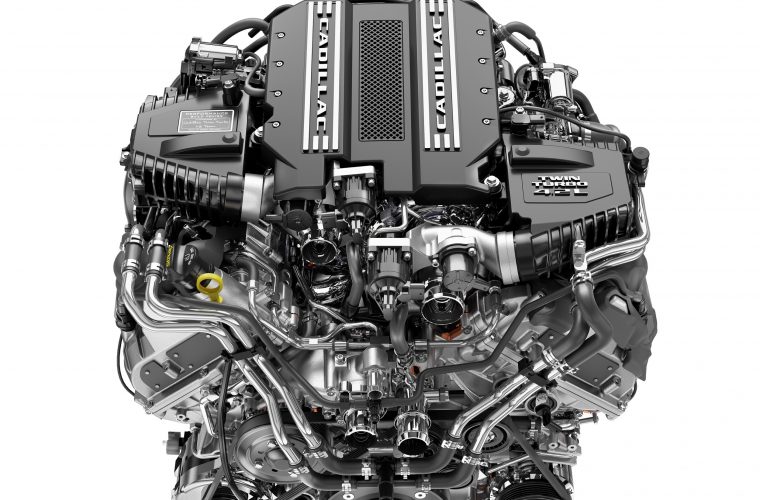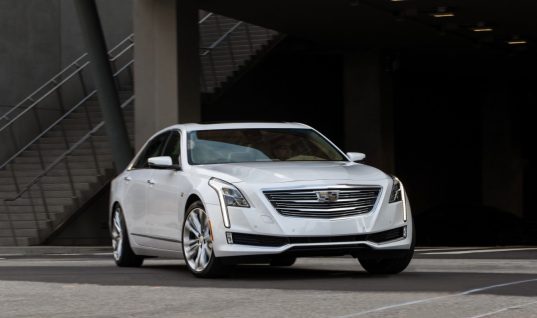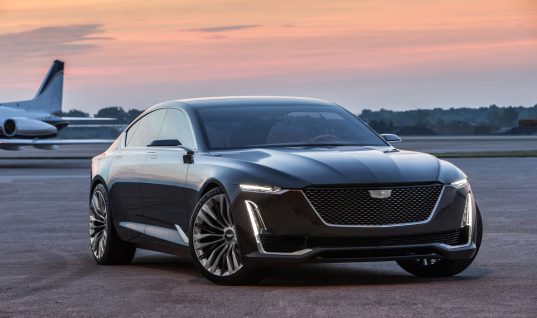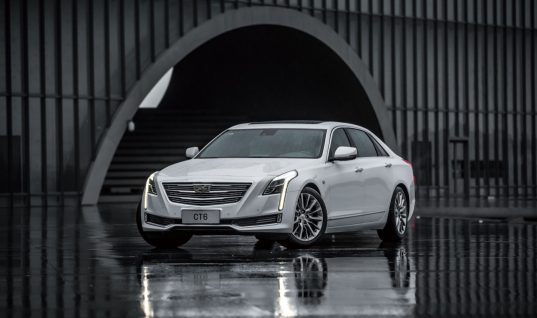Roughly two years ago, Cadillac announced that it’s working on a new Twin-Turbo V-8 engine. And today, it’s finally here.
Displacing 4.2 liters in a Dual Overhead Cam (DOHC) design with two turbochargers, the new engine is assigned RPO code LTA. It will make its debut in the 2019 Cadillac CT6, where it is rated as follows:
- 550 horsepower at 5,700 rpm and 637 pound-feet of torque between 3,200 and 4,000 rpm in the 2019 Cadillac CT6 V-Sport, and
- 500 horsepower at 5000-5200 rpm and 553 pound-feet of torque at 2600-4600 in the non-V-Sport CT6
Cadillac says that its new 4.2L Twin-Turbo V-8 will be exclusive to its own vehicles, though our friends at GM Authority believe that this might change, and that other vehicles such as the mid-engine Corvette will use the engine or a variant of it in the future. But that’s beside the point.
Blank Slate Design
The LTA was developed from a blank slate, as engineers focused on performance and small packaging. The result is an engine that is refined, powerful and rather compact for the amount of power it delivers.
Notably, this new Cadillac DOHC V-8 is decidedly different from any eight-cylinder engine used in a Cadillac vehicle over the past eight years for two primary reasons: not only is it a Dual Overhead Cam (DOHC) design, but it also features a “hot V” configuration that delivers a tidy and small packaging and astounding performance.

Dual Overhead Cam Design
The Cadillac 4.2L Twin-Turbo V-8 is the first Dual Overhead Cam (DOHC) eight-cylinder engine from Cadillac and its parent, General Motors, since the duo discontinued the Northstar V8 in 2010. Since then, all Cadillac and GM eight-cylinder engines were of the Overhead Valve (OHV) configuration otherwise known as “push-rod”.
The DOHC design lends itself to smoother operation compared to an OHV engine. And even though exceptions exist, DOHCs typically have a higher power-to-displacement ratio. For instance, a 4.2L DOHC motor will likely be more powerful than an OHV motor with the same displacement. But despite their more efficient use of displacement, DOHCs are typically larger in physical size compared to OHV engines, since the DOHC configuration is taller as a result of two cams residing above the valves.
“Hot V” Configuration
The new Cadillac V-8 LTA engine features what is now referred to as a “Hot V” configuration. To understand the Hot V design, it’s worth exploring how a traditional turbocharged engine works first.
In a typical turbo-charged engine, cylinder heads receive air through ports at the top of the engine, while exhaust exits lower through ports outside the manifolds, which connect to the turbos. In a “hot V” setup, by comparison, intake-charged air enters through the lower outside of the heads and exits through the top inside – where the turbochargers are integrated with the exhaust manifolds. This results in a quick spool-up, translating into more immediate power delivery. The design also enables closer mounting of the catalytic converters, for efficient packaging.
It’s worth noting that modern turbo-charged V-8 engines from Porsche, Audi and Mercedes-Benz utilize the same “hot V” configuration.

Twin-Scroll Turbochargers
The turbos feature a twin-scroll design that broadens their performance capability, offering quicker response and greater efficiency. Instead of a single spiral chamber (scroll) feeding exhaust gas from the exhaust manifold to drive the turbine on each turbocharger, the engine’s twin-scroll design has a divided housing with two exhaust gas inlets and two nozzles to drive the turbine. Generally, one of the nozzles contributes to quicker response and boost production, while the other contributes to overall peak performance.
Each of the engine’s integrated exhaust manifolds/turbocharger housings splits the exhaust channels from the cylinder head so the exhaust flows through separate scrolls based on the engine’s exhaust pulses. When matched with precise valve timing, that separation leverages exhaust-scavenging techniques to optimize gas flow, improves turbine efficiency and reduces turbo lag.
The electronically controlled wastegates – one per turbocharger – are used for more precise management of the engine’s boost pressure and subsequent torque response for smoother, more consistent performance. They are independently controlled on each cylinder bank to balance the turbo compressors’ output, for greater boost pressure response.
Water-To-Air Charge Cooling
An efficient water-to-air charge-cooling system contributes to the engine’s performance, enhancing the turbochargers’ effectiveness. Similar in concept to an engine’s radiator, the system’s intercoolers cool the boosted air charge before it enters the cylinders. Cooler air is denser, which means there is more oxygen in a given volume, resulting in optimal combustion and resulting more power.
The system on Cadillac’s 4.2L Twin-Turbo V-8 LTA engine features a pair of heat exchangers located above the valley-mounted exhaust manifold/turbocharger housings. The turbos pump pressurized air directly through the heat exchangers and into the cylinder heads. The heat exchangers are cooled by their own coolant circuit.
The intercoolers lower the air charge temperature by more than 130 degrees F (74 C), packing the combustion chambers with cooler, denser air. Also, the system achieves more than 80 percent cooling efficiency with only about 1 psi (7 kPa) flow restriction at peak power, which contributes to fast torque production.
Dual Throttle Bodies
Before entering the combustion chambers, the cooled air charge flows through a pair of throttle bodies, one for each engine bank. Each electronically-controlled throttle body has a 59mm diameter opening.
10-Speed Automatic Transmission Pairing
Cadillac’s new 4.2L V-8 Twin-Turbo engine will be paired to the new GM 10-speed automatic transmission (the 10L90) when used in the 2019 CT6.

Cadillac’s new 4.2L Twin-Turbo V-8 engine is paired to this 10-speed 10L90 automatic transmission in the 2019 CT6
Production
The new Cadillac twin-turbo V8 LTA will be hand-built at General Motors’ Performance Build Center in Bowling Green, Kentucky.
Stay tuned to Cadillac Society for Cadillac engine news and Cadillac news.
[nggallery id=6]





Tony
I see a V on the Horizon and it’s gonna be Straight Nasty… ?
Ron K
This new Twin Turbo Hot V setup with new 10 speed Transmission sounds HOT! I can see GM putting this into new C8 Corvette.